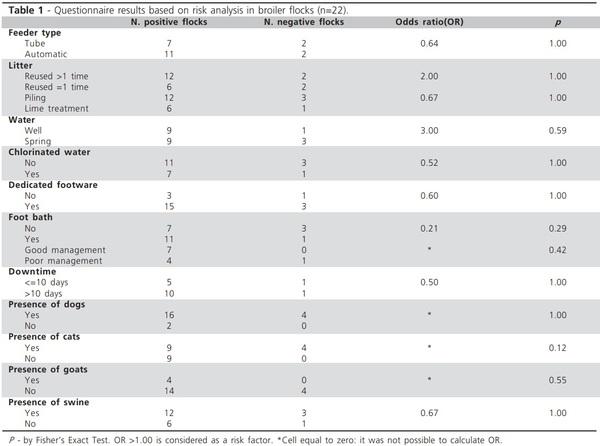INTRODUCTION
Poultry are important Campylobacter reservoirs, with 50 to 70% of human infections related with food preparation flaws and the consumption of poultry products (FAO/WHO, 2001). Campylobacter is frequently detected in the digestive tract of poultry, and particularly of broilers older than three weeks of age, rapidly disseminating until market age (Stern & Robach, 1995; Jacobs-Reitsma, 1995).
Campylobacter incidence in broilers may be related to management practices, such as feed distribution, litter and water treatment, workers’ protection, poultry house downtime, and the presence of other domestic animals (Hald et al., 2000; Berndson et al., 1996). Interventions on these factors could reduce the contamination by this agent (Pattison, 2001).
Therefore, Campylobacter was researched in the cecal droppings, feces, and cloacal swabs of 22 flocks of 3 to 5 week-old broilers in order to determine risk factors and likelihood of the presence of this agent in these flocks.
MATERIAL AND METHODS
The study was carried out from October to November, 2002, in broiler farms belonging to a company in the state of Santa Catarina, Brazil. A questionnaire was applied to investigate, using case-control study of risk factors (relative to farm biosecurity), the likelihood of contamination of a broiler flock by Campylobacter. The studied region presents high density of poultry farms. The evaluated poultry houses had dirt floor. Wood-shavings litter was reused for at least eight production cycles, and turned daily or every two days. The experimental unit was the poultry house (one house = one farm), which represented the flock, as it presented the same inherent and intrinsic conditions of the entire farm. Twenty two broilers houses (three measuring 600 m2 and 19 measuring 1.200 m2) were monitored. Farms with flock ages older than three weeks of age were randomly selected. This age was chosen because there is a higher and increasing Campylobacter colonization up to market age (Stern, 1995).
Chicks derived from different origins.
Broiler houses were equipped with nipple drinkers, automatic or tube feeders, and feed and water were offered ad libitum. Average bird density was 15 birds/m2.
Sampling plan consisted of a prospective transversal cut for a period of two months, during which 22 broiler houses were monitored. The number of birds monitored per flock varied between 9.027 and 70.179 flocks, representing a total number of 576.617 birds housed in an all-in, all-out production system. The presence of Campylobacter was assessed in 450 samples at the company’s laboratory.
Campylobacter research
Samples were randomly collected from 20 birds per flock, being 10 cloacal swabs, five feces samples, and five cecal droppings samples. Minimum bird age was 27 days, and maximum, 33 days.
The collected cloacal swabs were immediately placed in Cary Blair Medium (CM 519, Oxoid®) transport medium, in a total number of 230 samples. Both fresh feces and cecal droppings samples were collected in individual sterile plastic 50-ml flasks, in a total of 110 samples each. All samples were placed refrigerated, submitted to the laboratory in an ice-box, and processed immediately after arrival.
Campylobacter was researched using mCCDA culture medium (CM739, Oxoid®) with selective supplement (SR155, Oxoid). Counting was performed in Bolton broth (CM983, Oxoid) supplemented with antibiotics (SR183E, Oxoid), 15 g/L agar, 0.5g/L iron sulfate, and 200 mg/L TTC. Samples were incubated in microaerophilic environment with 5% O2, 10% CO2, and 85% N2 for 48h, and the suspected colonies were presumptively identified by catalase and oxydase, and confirmed in latex.
Risk factors and likelihood of the occurrence of Campylobacter
The people responsible for hygiene and biosecurity management of the 22 studied flocks were asked to answer a questionnaire. Cloacal swabs, and feces and cecal droppings samples were collected from these flocks for bacterial analyses. A flock was considered positive for Campylobacter if a single analyzed sample was positive for this agent.
The following parameters were evaluated: cleaning and disinfection procedures, disinfectant type and use, feeding practices (feed and water systems), wood shavings litter management, chlorinated water use, presence and effective use of foot bath, hand hygiene, use of flock-dedicated footware, presence of domestic animals, flock health as to medication use when disease occurred.
The relation of events and non-events between the studied group and the control group for each evaluated parameter assessed using Odds Ratio (OR) test, with the significance tested using Fisher’s test (P< 0.05), by the Statistical Package for the Social Sciences (SPSS). When the parameter presented an OR > 1.0, it was considered a risk factor.
RESULTS AND DISCUSSION
Out of the studied broiler flocks, 81.8% were positive for Campylobacter, but the evaluated parameters were not significantly associated with colonization by this agent (Table 1).
Automatic feeding systems were used in 59% of the flocks, and presented a higher number and higher likelihood (OR=0.64) of positive flocks as compared to flocks using tube feeders.
In 63.6% of the farms, litter was reused more than once, with a higher likelihood (OR= 2.0) of being infected with Campylobacter, but this was not statistically significant. Litter treatment by piling is common during downtime, and this was used in 68.2% of the flocks, which presented lower likelihood (OR=0.67) of infection. However, a higher likelihood of Campylobacter infection was observed when the litter was treated with lime.
Water well was used in 45.5% of the flocks, and presented higher likelihood of Campylobacter colonization (OR=3.00), but this was not statistically significant. Water was not treated with chlorine in 63.6 % of the flocks, and presented low likelihood (OR=0.52) of flock contamination. However, chlorinated drinking water was did not prevent Campylobacter colonization of positive flocks, as suggested by Pattison (2001) and Stern et al. (2002).
Stockpeople did not use dedicated footware to enter the broiler houses in 18.2% of the flocks, but this parameter presented low likelihood of Campylobacter contamination (OR=0.60). In fact, the number of positive flocks was higher when the stockpeople said they changed their footware. However, as they did this inside their own houses, shoe contamination possibly occurred on the way to the broiler houses, as there were dogs and other domestic animals in adjacent areas.
Foot baths were absent in 45.5% of the flocks, presenting a lower number of events (OR=0.21). However, when present but associated to poor lime management, it presented a higher number of positive flocks, despite the lack of statistical significance. Evans & Sayers (2000) recommend the effective use of foot bath and changing footware to delay the colonization by Campylobacter in broiler flocks.
Hald et al. (2000) demonstrated that downtime shorter than 14 days was a potential and significant risk factor for the colonization by Campylobacter. In contrast, in the present study, downtime shorter or equal to ten days presented lower likelihood of Campylobacter events (OR=0.50), whereas downtime longer than ten days resulted in a higher number positive flocks.
Other domestic animals were present in all farms; however, it was not possible to calculate the OR for some species, due the absence of frequency of some factors. In general, dogs, cats, and goats were present. Despite being a parallel activity in the region, the presence of swine in an adjacent, but separate area of the farm, was not a risk factor (OR=0.67).
The microbiological analysis identified that 81.8% of the studied flocks were positive for Campylobacter. Even in farms with good management practices, there was Campylobacter colonization of broilers, which suggests that hygiene could be improved, and that it is essential to decrease colonization up to market age (Stern et al., 2001).
Alternatives for the reduction of Campylobacter colonization, such as the use of probiotics, carbohydrates, and fructoligosaccharides in the feed or drinking water, are new areas to be studied for possible application in commercial broiler production. On the other hand, strategic interventions need to be developed for breeder farms, hatchers and hatchery environment to check the potential of vertical transmission of Campylobacter to the progeny (Cox et al., 2002).
CONCLUSION
The parameters evaluated as risk factors were not significantly associated with Campylobacter colonization in the studied broiler flocks, which were 81.8 % positive, as determined by bacteriological analyses.
This article was originally published in Revista Brasileira de Ciência Avícola, ISSN 1516-635X Jul - Sep 2007 / v.9 / n.3 / 201 - 204. This is an Open Access article distributed under a Creative Commons Attribution License.










